Current as of: December 19, 2025 - 20:53
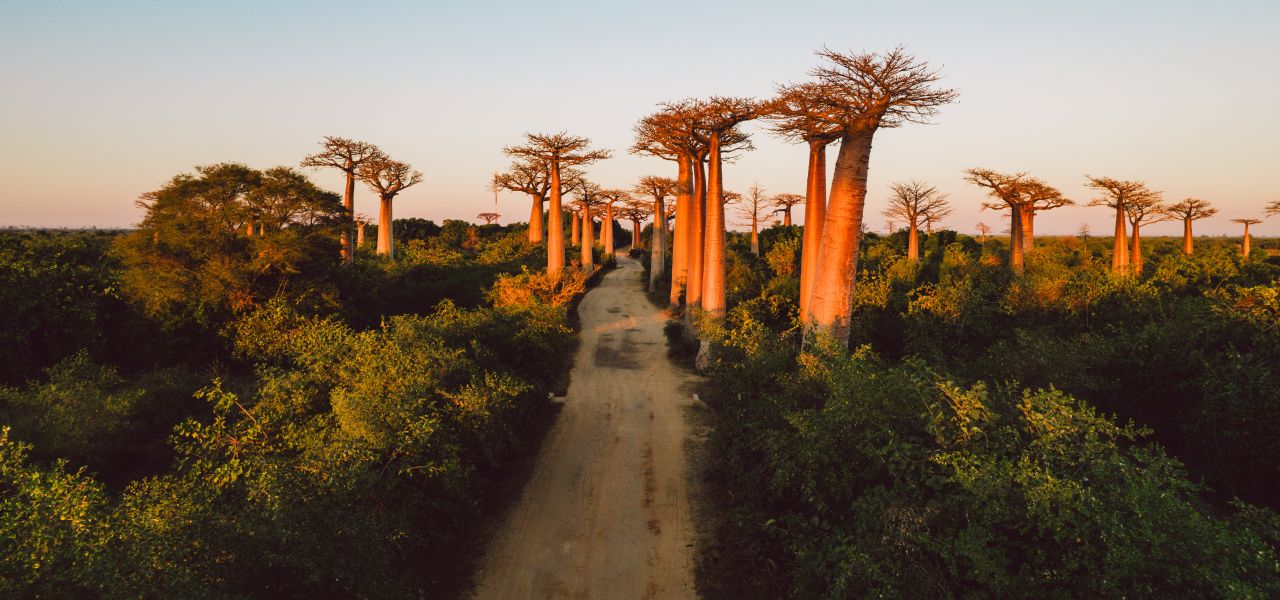
Madagascar Wildlife Adventure Trip Notes
- Ways to Travel: Guided Group
- Destination: Madagascar
- Programmes: Wildlife
-
Activity Level:
4 out of 7 - Moderate & Challenging
- 16 Days: Land Only
- Ages: 16+
- Trip Code: WMS
- Carbon Footprint: 60.2kg CO2e
Trip Overview
The wildest (and sometimes weirdest) wildlife show on Earth? Join our tour leader for a front-row seat
Madagascar is like nowhere else on the planet – the result of 80 million years of isolation. Here, alien landscapes – of stone forests, bulging baobab trees, and vast national parks – hide weird and wonderful creatures unique to this island. This in-depth adventure covers the extraordinary habitats and creatures of the south and west, while your expert tour leader unlocks the mysteries and shows you where bouncing lemurs put on their best show and other curious animals like to hide.
At a Glance
- Accommodation: 15 Classic nights (hotels)
- Travel by private bus, ferry and internal flights
- Group normally 4 to 12, plus leader. Minimum age: 16
Highlights
- Adventure through Madagascar to enjoy its most extraordinary wildlife displays
- Visit the iconic Avenue of the Baobabs at sunset – the most beautiful time to go
- Navigate the stone forests of the Big Tsingy, a totally unique landscape
- Explore multiple national parks with expert local guides
- Take a canoe ride on the Manambolo river to learn about the Bara ethnic group
- Enjoy a gentle bike ride to meet local people and explore traditional villages
Is This Trip for You?
This trip is rated Activity Level 4 (Moderate & Challenging) with a Wildlife Rating of Three. For more information on our trip gradings, visit the Activity Level Guidelines page or our Wildlife Holidays page for more on our Wildlife Ratings. If you have any queries about the difficulty of the trip, please contact us.
Madagascar is one of the world’s great wildlife-watching destinations; however, before you decide to travel, we consider the following:
- Madagascar is one of the poorest countries in the world and the infrastructure reflects this.
- Travelling in Madagascar can be uncomfortable as road conditions are far worse than in Europe and North America. Expect many narrow, winding and uneven sections of road. Roads away from the population hubs and main routes are generally unpaved dirt roads, which can be very bumpy.
- We do have some longer drives but the diverse scenery more than makes up for time spent on the bus. We break up our road journeys with stops at villages to take photos and stretch our legs.
- There are a lot of very early starts and long days.
- Tracking the wildlife can involve walking through difficult terrain at a quick pace.
- Parts of Madagascar are mountainous. You need to be prepared to walk in hills for up to four hours. The trails are fairly gentle in Andasibe but steeper in all the other national parks.
- The tourist infrastructure in Madagascar is new and some services are limited. It is not unusual for there to be changes to accommodation or internal flights; for this reason, the order of the itinerary (but not the content) may sometimes change. However, what tourism does exist is of a good standard and you may be impressed by the level of service in some of the places we stay.
This itinerary includes the use of pontoon ferries, which do not (typically) offer emergency safety equipment such as flotation devices. We have risk assessed these crossings and find them to be low risk. However, if you are concerned about this aspect, please consider an alternative trip as we are unable to facilitate the provision of Western safety equipment.
Water safety: This trip includes time by a lake, river or sea, where there may be opportunities to swim. You should always seek local advice before deciding whether to swim. Open-water or wild swim spots should be treated with extreme caution. Information on how to keep yourself safe while swimming is shown here.
Adult min age: 16
Min group size: 4
Max group size: 12
Itinerary

Land Only
- Start City: Antananarivo
- End City: Antananarivo
Land Only Itinerary
Begin your adventure in the characterful capital of Madagascar, Antananarivo, known as Tana by most.
Around 6pm, say salama (that’s hello in Malagasy) to your tour leader and fellow travellers, when we gather as a group for the first time to get to know each other and learn more about the adventures ahead.
Your tour leader then ensures a big Madagascan welcome by arranging a group dinner.
Want more time in Tana? Secure pre-tour hotel nights through your sales representative.
Accommodation: Relais des Plateaux (or similar)
Bid farewell to Tana, as we take a transfer to the airport for our flight to the west coast town of Morondava. From here, we drive to Kirindy Forest, stopping en route at the Avenue of the Baobabs. This short section of road, a key stop on any trip to Madagascar, is flanked by curiously fat-trunked baobab trees, some thought to be more than 1,000 years old.
Having completed our journey, we embark on a night walk in Kirindy Forest. Search this private nature reserve with expert local guides and the Exodus tour leader, keeping an eye out for any of the eight lemur species that live here.
Total drive time: Three hours on dirt road
Accommodation: Relais du Kirindy (or similar)
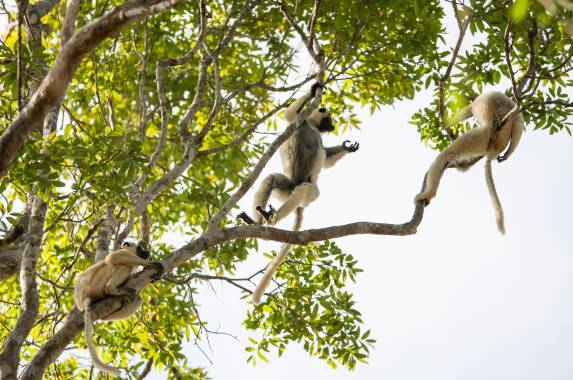
See a different side to Kirindy, enjoying an early morning forest walk. Led by local guides and our tour leader, we venture into the forest in full light, looking for even more lemur species, including the critically endangered Verreaux’s sifakas.
After, we drive to the town of Belo Tsiribihina, where we catch a ferry across the Tsiribihina River and continue to Bekopaka, a small village at the entrance of Tsingy de Bemaraha National Park, which we reach by another, much smaller, ferry.
Total drive time: Seven hours (including the ferry crossing)
Accommodation: Orchidée du Bemaraha (or similar)
Dedicate today to exploring Tsingy de Bemaraha National Park, home to extraordinary stone forests known tsingy and plenty of wildlife. On our easy walk (3mi/5km), we join eagle-eyed park guides and our tour leader to spot extraordinary creatures, such as Milne-Edwards mouse lemurs, white Decken’s sifakas, Bemaraha woolly lemurs and giant chameleons.
Our adventure begins in the morning with a two-hour canoe ride on the Manambolo river. With our canoe steersperson taking us gently along the waters, we explore caves and learn about the traditions and customs of the local Bara ethnic group from our park guide, a Bara member.
In the afternoon, we visit the Small Tsingy, an otherworldly collection of needle-like limestone rocks. Often described as a stone forest, the tsingy formations are like nowhere else on earth – plus we have the chance to spot ring-tailed lemurs and other local wildlife. Our exploration, which includes climbing rocks and ladders, is a great warm up for tomorrow, when we tackle the Big Tsingy.
Accommodation: Orchidée du Bemaraha (or similar)
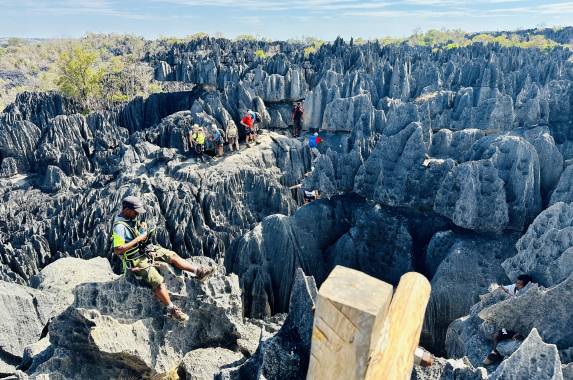
Enjoy an adventure-packed day exploring the Big Tsingy, where the magnificent limestone needles can reach double the size (up to 195ft/60m) of those in the Small Tsingy.
It’s a physically challenging day, as you need to crawl in some sections, wear a harness and climb up the tsingy – your efforts are well rewarded, however, with a chance to see a unique landscape formed over millions of years.
Bring a packed lunch from the hotel to enjoy your meal with unforgettable views. This is a day you won’t forget!
Total drive time: Two hours
Accommodation: Orchidée du Bemaraha (or similar)

We leave the tsingys behind and return to Morondava, taking the ferry across the Tsiribihina River again. It’s a long travelling day but we head back via the Avenue of the Baobabs for sunset, the most beautiful time to visit with the dark outlines of the trees backdropped by a sky changing colour.
Total drive time: Eight hours
Accommodation: Hotel Trecicogne (or similar)
We’re back in the vehicle today, this time driving (eight hours) through the desertic landscape of western Madagascar to the town of Miandrivazo.
Total drive time: Eight hours
Accommodation: Princesse Tsiribihina (or similar)
We drive (eight hours) to Antsirabe today, in the central highlands of Madagascar. There may be time for an optional boat excursion on the Mahajilo river this morning before our journey. Your tour leader can provide more information on the trip.
Our journey is a fascinating display of Madagascar’s diversity. We see it in the landscapes, through desert plains to rolling mountains, and architecture, in the one-level adobe houses of Miandrivazo to the multi-storey houses of Antsirabe.
Arriving in Antsirabe, there may also be time for an orientation tour upon arrival.
Total drive time: Eight hours
Accommodation: Chambres du Voyageur (or similar)
Spend today exploring Antsirabe and the surroundings by bike. Led by a local cycling leader, alongside our tour leader, we embark on a gentle 22mi (35km) ride. Exploring on two wheels allows us to get deep into Madagascan culture, visiting traditional villages and meeting the local people.
Our ride begins in the busy town centre, gradually shifting to quieter residential areas and finally to open countryside. We follow a dirt road for about 4mi (7km) towards Lake Andraikiba. The road is slightly hilly but manageable for most cyclists. During the excursion, we wrap around the lake, passing rice paddies, brick-making areas, and vegetable fields − reflecting the agricultural heritage of the region.
Total drive time: One hour
Accommodation: Chambres du Voyageur (or similar)
We depart Antsirabe today and transfer to Ranomafana National Park in the southeast of Madagascar. It’s a long drive on bumpy roads, but we do stop along the way to stretch our legs.
It’s also a journey through some of the most scenic and varied landscapes in Madagascar, transitioning from the cool highlands to lush rainforests. On the way, we stop at Ambositra, the capital of Malagasy woodcarving, great for buying souvenirs and observing artisan workshops.
Total drive time: Seven hours
Accommodation: Hotel Ny Tanàna (or similar)
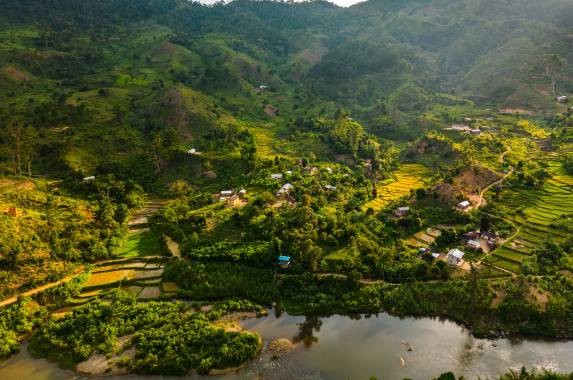
Head deep into Ranomafana for a full day exploring this World Heritage site. This landscape of medium-altitude rainforest is one of the great wildlife-watching destinations in the country, while also being home to endemic flora.
Guided by our tour leader, we take 6mi (10km) or so of trails (which can be slippery!) through the park, looking for some of the flagship species, including black-and-white ruffed lemurs, golden bamboo lemurs and greater bamboo lemurs. There are also nearly 100 amphibian species to spot, plus plenty of birdlife.
After dinner, we return to the edge of the rainforest (the park closes at 5pm) to explore the roadside near the entrance or adjacent forest edges for nocturnal animals, such as mouse lemurs, leaf-tailed geckos, Madagascar tree frogs, juvenile panther chameleons and giant pill millipedes.
Accommodation: Hotel Ny Tanàna (or similar)

There’s still plenty more to see in the park, where no two wildlife-watching days are the same. Visiting twice maximises our chances of spotting as many of the incredible creatures that live here as possible.
If you’d like a post-walk dip, you may wish to visit the thermal pool in Ranomafana, where you can swim in hot spring water. Or, if you’d like to return for another night walk tonight, you can join an optional excursion (both options payable locally).
Accommodation: Hotel Ny Tanàna (or similar)
We’re off to another of Madagascar’s great national parks today: Isalo. Breaking up the journey, we stop at Anjà Community Reserve, where we can easily spot ring-tailed lemurs, while also learning about the interesting funerary rites of the local Betsileo people with a visit to two family tombs on the cliffs.
Total drive time: Eight hours
Accommodation: Isalo Ranch (or similar)
Spend today exploring Isalo, a vast landscape of canyons, gorges and rock formations sculpted by wind and water. The mix of grassy plains, ochre-red soil and grey rock formations create a unique blend of Western landscapes and African savannah.
During our walk (less than 9mi/15km), we spot several species of lemurs and see the tombs of the local Bara people to gain a better understanding of the local culture and traditions.
Total drive time: One hour
Accommodation: Isalo Ranch (or similar)
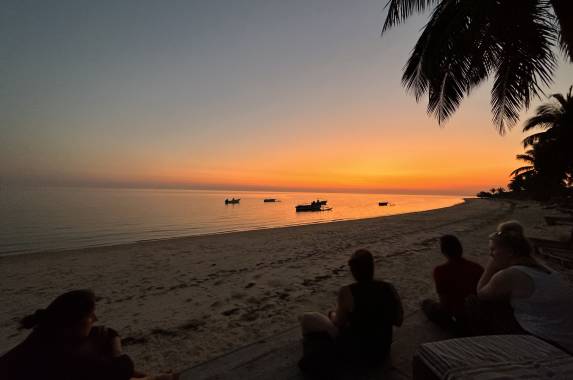
Bid farewell to Isalo and drive (8hr 30min) to Ifaty, ready for our flight back to Tana tomorrow. The rest of the day is free to relax and enjoy a final group dinner – a chance to relive our adventures together and remember some of our favourite moments.
Total drive time: 8hr 30min
Accommodation: Le Paradisier (or similar)
After breakfast, catch the one-hour transfer to Tuléar, in time for our flight back to Tana. Our trip concludes at Ivato International Airport.
If you’d like to continue your adventure, speak to your sales representative about extending your stay in Tana.
Accommodation
A selection of hotels
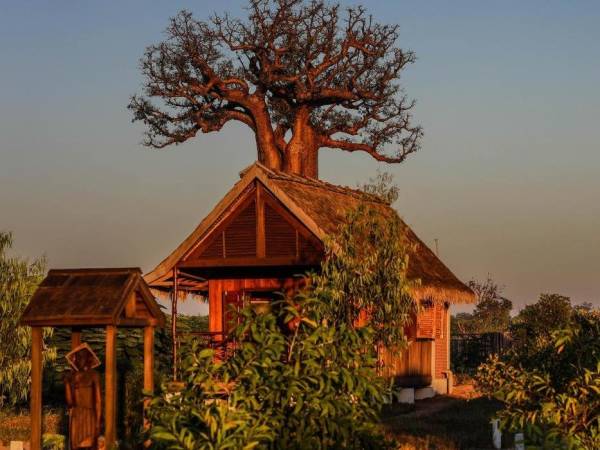
We aim to secure locally owned accommodation that is well located, offers good value for money, and plenty of comfort. To help you find your ideal adventure, each trip is given a Comfort Level rating, which indicates the overall standard of accommodation. For more on our ratings, see our Comfort Level guidelines.
Tailor your trip: Extend your adventure by securing extra hotel nights before or after the main itinerary. Speak to your sales representative to book.
Private rooms: Like most tour operators, we room solo passengers together. If you’d prefer to have a private room, it’s normally possible to do this for a supplement. Speak to your sales representative to book.
Single supplement from £ 685
Food & Drink
Food standards in Madagascar can vary and are probably not of the same standard you are used to at home. The cuisine has been strongly influenced by the French and a three-course meal should cost 43,000-70,000 ariary (US$10-US$16). A one-course lunch should cost 19,700-34,000 ariary (US$4.40-US$7.60). Please allow approximately 1.4m ariary (US$325) for the meals not included, plus a little more if you enjoy a drink with dinner.
Malagasy lager is reasonably priced and easily available. Malagasy wine is also reasonably priced but is not to everyone’s taste. It is sometimes possible to get hold of French or South African wine. A delicacy in Madagascar is flavoured rums, which are widely sold and very reasonably priced.
If you do not eat fish or meat, your food options will be limited (ie omelette, cheese, pasta, vegetables and rice). Breakfasts are usually simple: eggs, a baguette, jam and coffee or tea, and sometimes fruit. You may wish to bring something to supplement your morning meal (spread, peanut butter etc).
Transport
Travel is mainly by small private bus. Road conditions are far worse than in Europe and North America and you should expect many narrow, winding and uneven sections. Many of the roads away from the population hubs and main routes are unpaved dirt roads, which can be very bumpy. There are several days where the drives are long, with a maximum drive time of approximately 8hr 30min, but we make plenty of stops along the way. There are also two internal flights, plus ferry trips.
Weather & Seasonality
Madagascar has a tropical climate with two seasons: rainy and dry. The driest season extends from April to October. It can be cold on the central plateau (including Antananarivo) in the evenings, and in the rainforest areas, so bring warm clothes (fleece and waterproof). There is considerable regional variation, but coastal areas are normally very hot and dry. Expect daytime temperatures in the shade up to 38C (100F) from October to December and up to 30C (86F) from April to June and September.
Joining Instructions
Key information
Start hotel: Relais des Plateaux, Lot 66 B, Talatamaty
Phone: +261 32 05 678 93
Recommended arrival time: You can arrive at any time today. There will be a welcome briefing in the evening, but if you miss it the leader will update you separately
Airport: Ivato International Airport (TNR)
Getting to the start hotel
We provide one group transfer from the airport to the hotel, which you can join at no extra cost, provided you can be at the airport before the transfer leaves. Speak to your sales representative for the transfer times or to arrange a private transfer.
Catching your return flight
The adventure ends at Ivato International Airport, from where you can catch your onward flight.
Full joining instructions including local emergency numbers will be sent to you as part of our Final Joining Instructions. If you do not receive these at least a week before departure, or require them earlier please contact our office or your travel agent.
Location start: Antananarivo
Location end: Antananarivo
What To Take
Essential Equipment
- Lightweight clothing, including at least one pair of long trousers (pants) and a long‐sleeved shirt (for protection against mosquitoes and scratchy plants)
- Walking boots or training shoes with good tread
- Shoes you’re comfortable getting wet for canoe trip
- Rain jacket (all year round)
- Sunscreen
- Sunhat
- Sunglasses
- Torch (flashlight) for wildlife viewing at night and powercuts
- Backpack for camera, water bottle etc
- Mosquito repellent
Internal flights are subject to a weight limit of 44lb (20kg).
Water included: Plastic bottles are a big issue in many countries where recycling isn’t yet widely available; they often end up in landfill or get burned. Both processes are harmful to the environment and we would like to reduce our impact here. For your trip, we provide an alternative to single-use plastic bottles to reduce the plastic used. This means that safe drinking water will be available throughout; all you need to do is bring a bottle to refill along the way. Please add this to your packing list.
Optional Equipment
- Warm sweater or fleece jacket (nights can be chilly)
- Binoculars
- Camera
- Swimwear
- Earplugs
- Walking poles
Please note that tampons are virtually impossible to get hold of in Madagascar.
Due to laws in Madagascar about the dispensing of medicine, the guides are not able to carry any basic medicines should you feel unwell. These include paracetamol, Imodium and aspirin. Although they are available to buy in Madagascar, we advise you to bring them with you from home if you believe you may need them.
Practical Information
Visa
Madagascar
Visa requirements often change and it is your responsibility to obtain any required visas for this trip. Therefore, we recommend that you check with the nearest embassy or consulate of your chosen destination(s), including any countries you may be transiting or transferring through.
Some local governments provide guidance on what visas their citizens need. To help, we’ve gathered a selection of useful links below.
- Australia: www.smartraveller.gov.au/destinations/africa/madagascar
- Canada: www.travel.gc.ca/destinations/madagascar
- United Kingdom: www.gov.uk/foreign-travel-advice/madagascar/entry-requirements
- USA: www.travel.state.gov/content/travel/en/international-travel/International-Travel-Country-Information-Pages/Madagascar.html
Vaccinations and Health
Madagascar
Bilharzia is known to occur in some of the lakes or rivers visited on this itinerary, we therefore advise all to take advice from your guide or leader locally before venturing for a swim.
Local Time
Madagascar's time zone: Indian/Antananarivo (UTC +03:00)
Electricity
Madagascar's electricity: Plug types C (two round pins) and E (two round pins) – 220V, 50Hz

Money
Madagascar's currency: Malagasy ariary (MGA)
ATM Availability
ATMs accepting Visa and Mastercard are available in Antananarivo, Antsirabe and Tulear. However, due to frequent electricity cuts, ATMs may not always be available, and you cannot rely on credit cards for payment as they are not widely accepted.
Therefore, you should bring your spending money in euros or US dollars cash, as these are easiest to change to local currency. All money should be exchanged at the airport on arrival, as the banks in the provincial towns take a long time to process. Also, the exchange rate at the airport is generally better than in the banks.
Bills of €100 or US$100 usually get a better rate than bills of 20 or less. British pounds can only be exchanged at banks at the airport, but even there, they are not always accepted.
Extra Expenses & Spending Money
Optional excursions
Antananarivo:
Visit to Lemurs’ Park near Tana:
- 350,000 ariary (US$82) for one person
- 215,000 ariary (US$50) per person for two people
- 175,000 ariary (US$40) per person for three people
- 145,000 ariary (US$34) per person from four people
Tipping
Our local staff are paid fairly for their work. You may feel your tour leader has performed well and want to show your appreciation of their services. If you would like to tip your leader, we suggest approximately 22,000 ariary (US$5) per person per day.
It is also courtesy to tip any extra guides/drivers you may have over the course of the trip, though certainly not compulsory. Shortly after arrival, the tour leader will suggest to the group they donate a sum of approximately 400,000 ariary (US$90) per person towards a kitty on arrival. This money is then used for tipping local guides, hotel porters, drivers etc and will be distributed by the tour leader.
Sustainability and Impact
As a certified B Corp, we’re on a mission to improve our social and environmental impact across all our adventures.
We do this through our innovative Thriving Nature, Thriving People plan.
This ‘nature positive’ approach is designed to help nature and communities thrive in harmony through practical solutions, such as reducing carbon and waste on our trips, supporting conservation projects through the Exodus Adventure Travels Foundation, and rewilding 100 square metres for every Exodus traveller.
This trip goes near an area deemed unsafe to visit by the UK government’s Foreign, Commonwealth and Development Office, whose advice we follow when operating our trips. While our itinerary doesn’t go to these areas, you should familiarise yourself with your local government’s advice if you are planning any pre- or post-trip travel. Any independent travel to areas currently against your local government advice is entirely at your own risk and unlikely to be covered by your travel insurance.
Important Information
Your Safe Participation
When booking this trip, you should be confident in your ability to participate in all activities described in these Trip Notes. If you have any doubt about your suitability, please call us and ask to speak to one of the experts on this itinerary.
Although our leaders are well trained to deal with different capabilities, if they have any concerns about someone’s ability to safely take part in an activity, or their impact on other people’s enjoyment, we authorise them to take necessary action which, in some circumstances, may involve asking someone to miss that activity.
By booking this trip you agree to our Booking Conditions which clearly state that our leaders have the authority to do this. In these rare instances we will ensure anyone sitting out is safely provided for and offered alternative options where possible. Refunds will not be provided for activities missed and customers may be liable for additional costs incurred.
Seatbelts
All vehicles used by us should be equipped with working seatbelts, except where approved by us based on the vehicle type or journey. Wherever seatbelts are available, we require our customers to use them for their own safety, even where it may not be a legal requirement.
Travel Safety
For additional information please have a look at the travel safety advice page on our website.
How to Book
Speak to our friendly team of experts to plan your adventure:
- Check availability: our website shows real-time availability or contact our team by phone, email or live chat.
- Hold a space: You can provisionally hold a space to give you time to finalise your travel plans.
- Confirm your booking: Payment of a deposit will complete your booking and secure your place on the trip.
After booking
You will receive a confirmation document and invoice, which includes extra information and guidance about your travel arrangements. Our dedicated Customer Operations team will help you with any pre-travel questions or arrangements and can easily add extensions or extra accommodation to your booking. Final Joining Instructions will usually be sent out two to three weeks prior to departure.
Adding transfers to your booking
If you have arranged your own flights and would like to add transfers to your booking, please provide your arrival and departure details to our Customer Operations team around four to six weeks before departure.
- Where free transfers are included, they are available for any flight but can only be added to your booking once we have received your flight schedule.
- Where group arrival and departure transfers are available, these operate at fixed times. You will need to arrive in time to meet the scheduled transfer. If the timings don’t align with your travel plans, our team can arrange private transfers once they receive your flight schedule.
Trip Note validity
Trip notes may be updated after booking; if any updates significantly impact the inclusions or itinerary you will be advised in writing. A link to the most up-to-date Trip Notes will be sent out with your Final Joining Instructions before departure.
The information in these Trip Notes is given in good faith. All holidays can be subject to unexpected changes, and occasionally it may not be possible to follow the itinerary as planned. In these circumstances we will make the best-possible alternative arrangements that maintain the integrity of the original itinerary.
